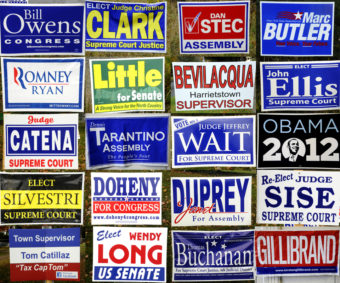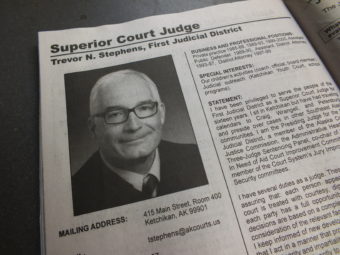
Did you ever wonder why you never see campaign signs for Alaska judges, like in other states?
There are 33 judges on this year’s election ballot. Yet probably none of them are producing radio and television ads, putting fliers in the mail, or taking out ads in the newspaper promoting their credentials as a judge and asking to remain on the bench. And, for sure, Alaska judges never accept large campaign contributions from lawyers, lobbyists, and special interest groups.
Susan DiPietro is the executive director of the Alaska Judicial Council.
“It’s pretty obvious in other states where judges campaign, the main contributors to the campaigns are lawyers,” DiPietro said. “At that point, when you would go to court, you wouldn’t know if the other person in court actually contributed to the campaign of that judge. That would be something to worry about. (The state of Alaska’s founders) wanted to avoid it. They also wanted to avoid judges campaigning and being sort of pressed into making certain promises about how they might rule in a certain case. It’s totally inappropriate and not fair.”
DiPietro said the code of conduct for Alaska judges prohibits them from campaigning unless they are attacked.
Former Alaska Supreme Court Justice Bud Carpeneti said members of the Constitutional Convention sixty years ago wanted to isolate judges from election politics.

“Judges have to be primarily responsive to the law. They have to apply the law fairly,” Carpeneti said. “I think the founders wanted to get away from the notion that it would just be another political branch. Because, when you go into court, sometimes the unpopular side might be (the) side that has more legal merit and ought to win.”
Carpeneti said Tom Stewart, a territorial legislator and secretary to the Constitutional Convention, traveled around the country to research how other states did things. He came back with something called the merit selection plan or the Missouri Plan.
DiPietro said 38 states use merit selection to fill some or all of their judicial vacancies.
A non-partisan panel would interview and thoroughly vet judicial applicants, and then hold public hearings. The Governor would essentially be the political component representing the people while making the final selection from a short-list of best-qualified nominees. During retention elections held later, voters have a direct say on whether they think each judge is still doing a good job.
“So, the Council’s process really starts a whole year in advance,” DiPietro said.
The Alaska Judicial Council is the non-partisan panel responsible for putting all judicial applicants and sitting judges through a fine-tooth comb.
“The Council tries to determine how a judge performed in office, over their last term in office by surveying people who have appeared in front of that judge,” DiPietro said. “So, the idea is that the people who have been in the judge’s courtroom, read the judge’s decisions, those are the people who are going to give the Council the most up-to-date information about the judge’s performance.”
DiPietro said the Alaska Judicial Council is recommending that all 33 judges on the ballot this year be retained.
“It’s a lot more than usual and that’s just really a coincidence,” DiPietro said. “It’s almost half of the judges sitting in Alaska right now.”
But voters won’t have to decide on each and every judge. They only have to consider the two Supreme Court justices, a Court of Appeals judge, and the Superior and District Court judges in their particular area or judicial district.
The judges up for retention in the First Judicial District are:
- Superior Court Judge David George, who was a private attorney in Juneau and Sitka before he was appointed to the bench in Sitka in 2007.
- Superior Court Judge Philip Pallenberg, who was a public defender in Kodiak and Juneau and a private attorney before he was appointed to the bench in Juneau in 2007.
- Superior Court Judge Trevor Stephens, who worked as a public defender and a prosecutor before he was appointed to the bench in Ketchikan in 2000. Stephens, also the presiding judge for Southeast Alaska, frequently travels to hear cases in many smaller communities.
- District Court Judge Thomas Nave, who worked in the Public Defender Agency as an attorney and deputy director, and as a private attorney before being appointed to the bench in Juneau in 2010. He presides over the Therapeutic Court which helps defendants overcome their addictions.

Voters can check out those surveys, or what attorneys, peace officers, social service professionals, jurors and courthouse employees think of each judge in the election pamphlet that arrived in mailboxes recently. Judges are rated on legal ability, impartiality, integrity, temperament and diligence. You can also check out those surveys at knowyouralaskajudges.com
Carpeneti, who served as a judge and justice for a total of 31 years, came up for a retention vote several times.
“It’s a little bit of a scary process because during the course of a judge’s term – let’s say a trial judge on the Superior Court, that’s a 6 year term – you’re going to make thousands of decisions. In every one of those cases, pretty much someone will have won and someone will have lost,” Carpeneti said. “So, there’s the potential for thousands of individuals or corporations or whoever the litigants are to be upset with your ruling.”
Once a special interest group begins campaigning against retention of a particular judge – such as what’s happening with two Alaska Supreme Court justices on the ballot this year – then that judge can mount a defensive campaign.
“Even there, it’s a little bit difficult because a judge has to keep a little bit removed from the operation of the campaign with the understanding that if the judge is retained, he or she is going to going to have to make decisions in the future,” Carpeneti said. “So, there is definitely some distance between the judge and the people that do the organizing on his or her behalf.”
DiPietro recommended that voters consider each judge’s performance and body of work and not whether they agree or disagree with the outcome of a single case.
Matt Miller is a reporter at KTOO in Juneau.




